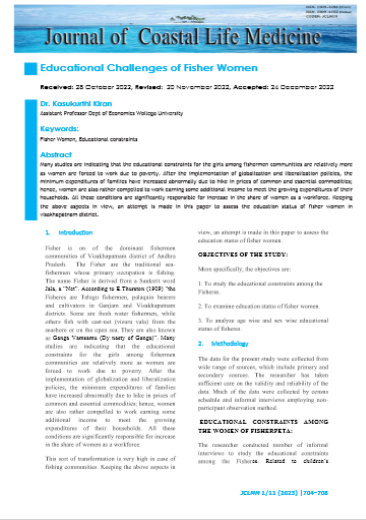Educational Challenges of Fisher Women
Main Article Content
Abstract
Many studies are indicating that the educational constraints for the girls among fishermen communities are relatively more as women are forced to work due to poverty. After the implementation of globalization and liberalization policies, the minimum expenditures of families have increased abnormally due to hike in prices of common and essential commodities; hence, women are also rather compelled to work earning some additional income to meet the growing expenditures of their households. All these conditions are significantly responsible for increase in the share of women as a workforce. Keeping the above aspects in view, an attempt is made in this paper to assess the education status of fisher women in visakhapatnam district.
Article Details
References
Anon., 2000. State level workshop on Fisheries Development. NABARD, Trivandrum.
Arpita, S., 2000. Evaluation of socio-economic conditions and ergonomical problems of women engaged in prawn peeling in Mumbai region. Project report, CMFRI. Gopakumar, K., 1998. Utilisation of by-catches and low-value fish in India. In James, D. G. (ed.), Fish utilisation in Asia and Pacific. Proceedings of the APFIC symposium, Beijing, 24-26 Sept.
Immanuel, S., N. Kumar, S. Ashaletha, C. Ramachandran and V. P. Vipinkumar, 2000. Empowerment of Coastal communities through fisheries extension. Project rep~rt, CMFRI
Kumar, N. R. and R. Sathiadhas, 2001. Economics of resource management and socio-economics of small-scale fisheries. Project report, CMFRI.
Madhu, S.R., 1989. Fisherwomen of the Bay of Bengal, Naga, 12(2):3-5.
Menon, A.G.G. and C. Bhaskaran, 1988. In Kerala, the coconut country technology alters traditional attitudes. Indian Farming, xxxviii (8):45.
Meynen, Wicky , 1989. Fisheries development, resource depletion, and political mobilization in Kerala: the problem of alternatives. Development and Change, 20: pp.738-39.
Muhammed, P.B., 2000. "Matsyavipaniyude kanapurangal' Published by Extension Division of Matsyafed, State Department of Fisheries.
Mukherjee, M., 1983. Impact of modernisation on women's occupation: a case study of the rice-husking industry of Bengal. Indian Economic and Social History Review, 20 (1): 27-45.
Muylwijk, Joke, 1995. Gender issues in agricultural research and extensionautonomy and integration. In Samantha, R.K. (ed.), Women in agricultureperspective, issues and experiences, pp.1-23. MD Publications, New Delhi.
Pushpangadan, K. and G. Murugan, 2000. Gender bias in a marginalized community- a study of fisherfolk in coastal Kerala. Working paper, Center for Development Studies, Trivandrum.
Samantha, R.K., 1995. Improving women farmers' access to extension services. In Samantha, R.K. (ed.), Women in agriculture- perspective, issues and experiences, pp.1-23. M. D. Publications, New Delhi.
Sassi and V. A. Ramachandran, 1998. Studies on the organisational structure, leadership style and communication in.the seafood industry in Kerala with respect to their applicability for total quality management. In James, D. G. (ed.), Fish utilisation in Asia and Pacific .Proceedings of the APFIC symposium, Beijing, 24-26 Sept.
Sen, AmarLya, 2001. Many faces of gender inequalily. Fromline, November. 2001.
Shet, Muktha, 1994.Ir.lpact of fisheries technologies on fisherwomen. In Giriappa (ed.), Role of fisheries in rural development, Daya Publications. New Delhi.
State Planning Board, 1997-2002. Report of the Task force on fisheries. Government of Kerala.
Velayuthan, T. D., 1999. Issues for fish marketing and scope for intervened by the local bodies. Fishing Chimes, 18 (11). Viswanathan, S., 1996. Women and work-from housewifesation to androgyny. Economic and Political weekly. November 9-16, 1996.

